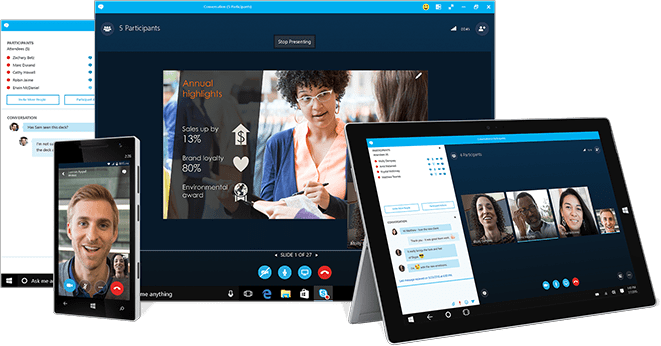

This limitation meant that only PIN Authentication could be used on the phone.
Skype for business trial account Pc#
This phone was slightly smaller than the standard phone designed for regular users and did not come with the USB-B port required to leverage the ‘Better Together’ pairing capability with a PC which allowed for basic user authentication. At the same time Polycom also released an IP handset designed specifically for the CAP scenario: the CX500. Thus Microsoft created PIN Authentication for Lync Server to provide a way to sign into a phone using contact objects. This configuration leveraged an Active Directory Contact object which could not utilize traditional authentication methods, nor could they be mailbox-enabled.

When Lync Server 2010 was released Microsoft added a special account configuration to allow basic calling features on a phone without the unneeded overhead and licensing costs associated with voice mail or other mailbox-related features included with a regular user account. No account configuration was provided nor any phone models designed specifically for that use-case. Backgroundīack when IP phones were first introduced with Office Communications Server a common area phone option was not yet available.

Devices in those spaces should instead use a meeting room account configuration. In general common area phones should simply not be deployed in a space where users would need to join meetings. It would still be possible to manually dial into a meeting if the invitation includes an audio conferencing number, but the invite would still not be viewable on the phone itself to see the dial-in information. This is the main reason that they should not be deployed in a typical conference room as without a mailbox there is no calendar, and without a calendar there is no way to invite that device to a scheduled meeting. Throughout the Microsoft UC journey the common area phones have had a very deliberate distinction that there is no mailbox available to them. Then depending on the configuration and licensing of the account assigned to the phone various additional features could be made available, like searching for other users or placing non-emergency calls to local or even international numbers. Often the baseline requirement is for a phone that will always be registered so that emergency services can be dialed without issue or delay. They are not tied to a specific person and thus features like contacts, voice mail, or a calendar are not really applicable. These are phones which may be located in areas like break rooms, front lobbies, shared spaces, warehouses, factory floors, etc. Common spaces typically don’t have calls coming into them as usually no one would know who is in that space at a given time, less anyone at all. Essentially the requirement is just for ‘dial tone’ to facilitate placing outbound calls to other users in the same organization, other organizations, PSTN numbers, and/or emergency services. Thus a core trait of the common area phone scenario is providing basic calling capabilities and not much of anything else. Generally the ideal of a common area phone is just that: a phone located in a shared space which only needs to provide the ability to place phones calls to other users and/or phone numbers.
Skype for business trial account software#
The deployment and administrative experience for a Common Area Phone (CAP) across Microsoft’s UC platform has changed over the years as it has matured from an on-premises software release with Lync to hybrid offerings of Skype for Business only to eventually be replaced by the cloud-only Microsoft Teams solution.


 0 kommentar(er)
0 kommentar(er)
